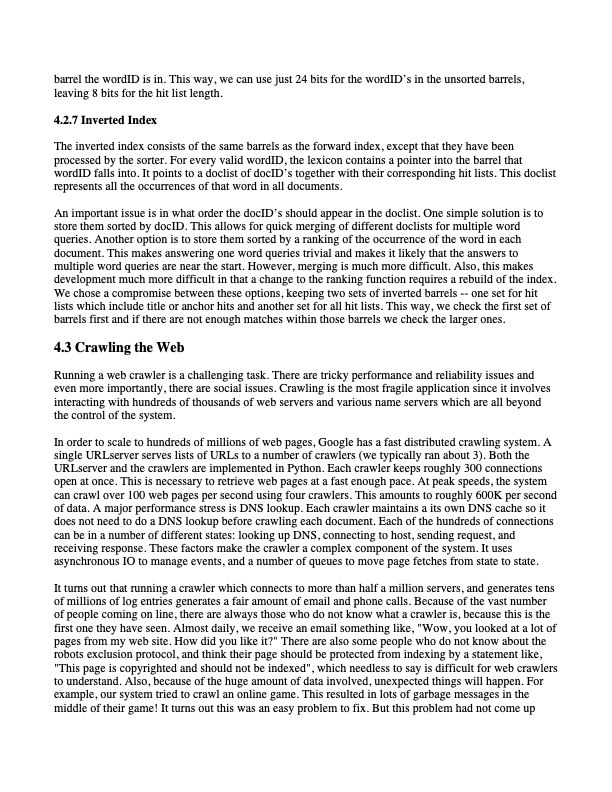
PDF Publication Title:
Text from PDF Page: 010
barrel the wordID is in. This way, we can use just 24 bits for the wordID’s in the unsorted barrels, leaving 8 bits for the hit list length. 4.2.7 Inverted Index The inverted index consists of the same barrels as the forward index, except that they have been processed by the sorter. For every valid wordID, the lexicon contains a pointer into the barrel that wordID falls into. It points to a doclist of docID’s together with their corresponding hit lists. This doclist represents all the occurrences of that word in all documents. An important issue is in what order the docID’s should appear in the doclist. One simple solution is to store them sorted by docID. This allows for quick merging of different doclists for multiple word queries. Another option is to store them sorted by a ranking of the occurrence of the word in each document. This makes answering one word queries trivial and makes it likely that the answers to multiple word queries are near the start. However, merging is much more difficult. Also, this makes development much more difficult in that a change to the ranking function requires a rebuild of the index. We chose a compromise between these options, keeping two sets of inverted barrels -- one set for hit lists which include title or anchor hits and another set for all hit lists. This way, we check the first set of barrels first and if there are not enough matches within those barrels we check the larger ones. 4.3 Crawling the Web Running a web crawler is a challenging task. There are tricky performance and reliability issues and even more importantly, there are social issues. Crawling is the most fragile application since it involves interacting with hundreds of thousands of web servers and various name servers which are all beyond the control of the system. In order to scale to hundreds of millions of web pages, Google has a fast distributed crawling system. A single URLserver serves lists of URLs to a number of crawlers (we typically ran about 3). Both the URLserver and the crawlers are implemented in Python. Each crawler keeps roughly 300 connections open at once. This is necessary to retrieve web pages at a fast enough pace. At peak speeds, the system can crawl over 100 web pages per second using four crawlers. This amounts to roughly 600K per second of data. A major performance stress is DNS lookup. Each crawler maintains a its own DNS cache so it does not need to do a DNS lookup before crawling each document. Each of the hundreds of connections can be in a number of different states: looking up DNS, connecting to host, sending request, and receiving response. These factors make the crawler a complex component of the system. It uses asynchronous IO to manage events, and a number of queues to move page fetches from state to state. It turns out that running a crawler which connects to more than half a million servers, and generates tens of millions of log entries generates a fair amount of email and phone calls. Because of the vast number of people coming on line, there are always those who do not know what a crawler is, because this is the first one they have seen. Almost daily, we receive an email something like, "Wow, you looked at a lot of pages from my web site. How did you like it?" There are also some people who do not know about the robots exclusion protocol, and think their page should be protected from indexing by a statement like, "This page is copyrighted and should not be indexed", which needless to say is difficult for web crawlers to understand. Also, because of the huge amount of data involved, unexpected things will happen. For example, our system tried to crawl an online game. This resulted in lots of garbage messages in the middle of their game! It turns out this was an easy problem to fix. But this problem had not come upPDF Image | natomy of a Large-Scale Hypertextual Web Search Engine

PDF Search Title:
natomy of a Large-Scale Hypertextual Web Search EngineOriginal File Name Searched:
google-anatomy-of-a-search-engine.pdfDIY PDF Search: Google It | Yahoo | Bing
Cruise Ship Reviews | Luxury Resort | Jet | Yacht | and Travel Tech More Info
Cruising Review Topics and Articles More Info
Software based on Filemaker for the travel industry More Info
The Burgenstock Resort: Reviews on CruisingReview website... More Info
Resort Reviews: World Class resorts... More Info
The Riffelalp Resort: Reviews on CruisingReview website... More Info
| CONTACT TEL: 608-238-6001 Email: greg@cruisingreview.com | RSS | AMP |